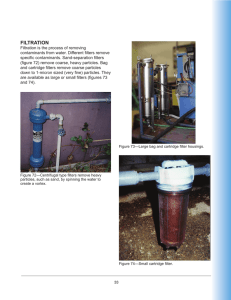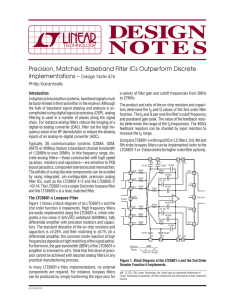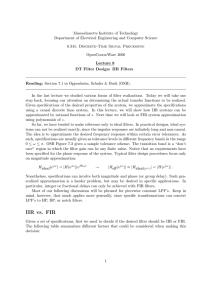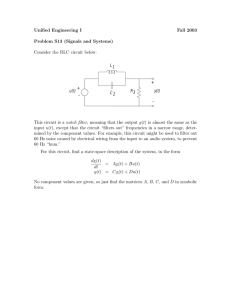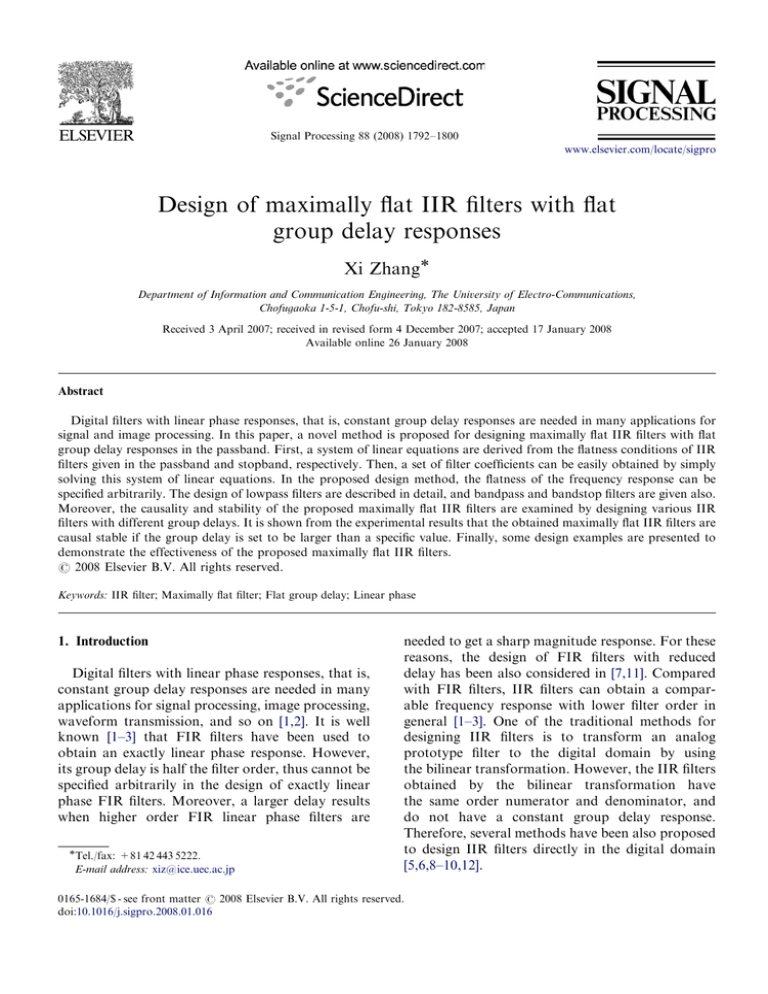
ARTICLE IN PRESS
Signal Processing 88 (2008) 1792–1800
www.elsevier.com/locate/sigpro
Design of maximally flat IIR filters with flat
group delay responses
Xi Zhang
Department of Information and Communication Engineering, The University of Electro-Communications,
Chofugaoka 1-5-1, Chofu-shi, Tokyo 182-8585, Japan
Received 3 April 2007; received in revised form 4 December 2007; accepted 17 January 2008
Available online 26 January 2008
Abstract
Digital filters with linear phase responses, that is, constant group delay responses are needed in many applications for
signal and image processing. In this paper, a novel method is proposed for designing maximally flat IIR filters with flat
group delay responses in the passband. First, a system of linear equations are derived from the flatness conditions of IIR
filters given in the passband and stopband, respectively. Then, a set of filter coefficients can be easily obtained by simply
solving this system of linear equations. In the proposed design method, the flatness of the frequency response can be
specified arbitrarily. The design of lowpass filters are described in detail, and bandpass and bandstop filters are given also.
Moreover, the causality and stability of the proposed maximally flat IIR filters are examined by designing various IIR
filters with different group delays. It is shown from the experimental results that the obtained maximally flat IIR filters are
causal stable if the group delay is set to be larger than a specific value. Finally, some design examples are presented to
demonstrate the effectiveness of the proposed maximally flat IIR filters.
r 2008 Elsevier B.V. All rights reserved.
Keywords: IIR filter; Maximally flat filter; Flat group delay; Linear phase
1. Introduction
Digital filters with linear phase responses, that is,
constant group delay responses are needed in many
applications for signal processing, image processing,
waveform transmission, and so on [1,2]. It is well
known [1–3] that FIR filters have been used to
obtain an exactly linear phase response. However,
its group delay is half the filter order, thus cannot be
specified arbitrarily in the design of exactly linear
phase FIR filters. Moreover, a larger delay results
when higher order FIR linear phase filters are
Tel./fax: +81 42 443 5222.
E-mail address: xiz@ice.uec.ac.jp
needed to get a sharp magnitude response. For these
reasons, the design of FIR filters with reduced
delay has been also considered in [7,11]. Compared
with FIR filters, IIR filters can obtain a comparable frequency response with lower filter order in
general [1–3]. One of the traditional methods for
designing IIR filters is to transform an analog
prototype filter to the digital domain by using
the bilinear transformation. However, the IIR filters
obtained by the bilinear transformation have
the same order numerator and denominator, and
do not have a constant group delay response.
Therefore, several methods have been also proposed
to design IIR filters directly in the digital domain
[5,6,8–10,12].
0165-1684/$ - see front matter r 2008 Elsevier B.V. All rights reserved.
doi:10.1016/j.sigpro.2008.01.016
ARTICLE IN PRESS
X. Zhang / Signal Processing 88 (2008) 1792–1800
In the design of maximally flat (MF) filters, MF
IIR filters can be obtained by transforming analog
Butterworth filters, while MF FIR filters were
originally addressed in [4]. The generalized digital
Butterworth filters with different order numerator
and denominator, including the classic Butterworth
IIR filters and FIR filters, have been also presented
in [8], however, their group delay responses cannot
be specified arbitrarily. In [5,6], a special class of IIR
filters, all-pole filters have been used to approximate
the passband group delay response to a constant in
the maximally flat sense. In [9], such an all-pole filter
with constant group delay response was chosen to
be the denominator, while a mirror image polynomial was used as the numerator to have a flat
magnitude response. Therefore, the degree of
flatness in the magnitude and group delay responses
are separately determined by the numerator and
denominator. In [10], IIR lowpass filters with MF
magnitude responses, whose numerator is a mirror
image polynomial, have been presented by using the
above-mentioned all-pole filters, where the flat
group delay response can be also obtained by
appropriately adjusting the delay of the filter,
resulting in a parallel structure of a delay and an
allpass filter. In [12], MF IIR halfband filters, a
special case of IIR filters, have been derived directly
from the maximal flatness conditions given in the
passband and stopband, including the flatness
condition imposed on the group delay response.
In this paper, we consider a more general class of
IIR filters with different order numerator and
denominator, whose numerator is not restricted to
be a mirror image polynomial. We propose a novel
method for designing MF IIR filters with flat group
delay responses in the passband. In the proposed
design method, a system of linear equations are
derived directly from the flatness conditions of IIR
filters given in the passband and stopband. Therefore, a set of filter coefficients can be easily
calculated by simply solving this system of linear
equations. The feature of this method is that the
flatness of the frequency response can be specified
arbitrarily. This design method can be applied to
not only the design of lowpass filters, but also
highpass, bandpass and bandstop filters. Moreover,
the causality and stability of the proposed MF IIR
filters are examined by designing various IIR filters
with different group delays. It is shown from the
experimental results that the proposed MF IIR
filters become causal and stable when the desired
group delay is chosen above a certain value. Finally,
1793
some examples are designed to demonstrate the
effectiveness of the proposed MF IIR filters.
This paper is organized as follows. In Section 2,
the transfer function and frequency response of
general IIR filters are described. Section 3 proposes
a design method for MF lowpass filters with flat
group delay responses. The proposed method is
extended to the design of MF bandpass and
bandstop filters in Section 4. In Section 5, the
causality and stability of the proposed MF IIR
filters are examined, and some examples are shown
to investigate their frequency responses. Conclusions are given in Section 6.
2. The transfer function of IIR filters
The transfer function of an IIR filter HðzÞ is
defined by
PN
AðzÞ
an zn
HðzÞ ¼
¼ PMn¼0
,
(1)
m
BðzÞ
m¼0 bm z
where N; M are numerator and denominator
orders, respectively, an and bm are real filter
coefficients, and b0 ¼ 1. It is noted that the classic
IIR filters obtained by the bilinear transformation
have the same order numerator and denominator,
i.e., N ¼ M. Here we use the numerator and
denominator of different order, which makes us
flexible to design the filter. If N ¼ 0, it is an all-pole
filter in [5], while if M ¼ 0, it degrades to FIR filter.
In this paper, we do not restrict the numerator AðzÞ
to be a mirror image polynomial, and will consider
the design of general IIR filters.
The frequency response of HðzÞ is generally a
complex-valued function of the normalized frequency o;
PN
an ejno
jo
jo
jyðoÞ
Hðe Þ ¼ jHðe Þje
¼ PMn¼0
,
(2)
jmo
m¼0 bm e
where its magnitude and phase responses are given,
respectively, as
sffiffiffiffiffiffiffiffiffiffiffiffiffiffiffiffiffiffiffiffiffiffiffiffiffiffiffiffiffiffiffiffiffiffiffiffiffiffiffiffiffiffiffiffiffiffiffiffiffiffiffiffiffiffiffiffiffiffiffiffiffiffiffiffiffiffiffiffiffiffiffiffiffiffiffiffiffiffiffiffiffiffi
ffi
P
PN
2
2
ð N
n¼0 an cos noÞ þ ð
n¼0 an sin noÞ
,
jHðe Þj ¼
P
PM
2
2
ð M
m¼0 bm cos moÞ þ ð
m¼0 bm sin moÞ
jo
(3)
yðoÞ ¼ tan
1
PN
PNn¼0
n¼0
PM
an sin no
an cos no
m¼0
þ tan1 PM
bm sin mo
m¼0 bm
cos mo
.
(4)
ARTICLE IN PRESS
X. Zhang / Signal Processing 88 (2008) 1792–1800
1794
Then its group delay response is obtained by
dyðoÞ
.
(5)
do
It should be noted that unlike [9,10], the numerator
will contribute to the group delay also, since it is not
restricted to be a mirror image polynomial.
tðoÞ ¼ 3. Design of MF lowpass filters
In this section, we consider the design of MF
lowpass filters with flat group delay response. The
desired frequency response of lowpass filters is
(
ejt0 o ð0popop Þ;
jo
H d ðe Þ ¼
(6)
0
ðos poppÞ;
where t0 is the desired group delay in passband, and
op ; os are the cutoff frequencies of passband and
stopband, respectively. In passband, the flatness
conditions of the magnitude and group delay
responses are given by
8
jo
¼ 1;
>
< jHðe Þjjo¼0
i
q jHðejo Þj
(7)
¼ 0 ði ¼ 1; 2; . . . ; K 1Þ;
>
: qoi o¼0
8
¼ t0 ;
>
< tðoÞjo¼0
qi tðoÞ
¼0
>
: qoi o¼0
ði ¼ 1; 2; . . . ; K 2Þ;
(8)
where K is a parameter that controls the degree of
flatness in passband. In stopband, the flatness
condition of the magnitude response is
qi jHðejo Þj
¼ 0 ði ¼ 0; 1; . . . ; L 1Þ,
(9)
qoi o¼p
where L is a parameter that controls the degree of
flatness in stopband.
First, we consider the flatness conditions in
^ jo Þ be a noncausal shifted version
passband. Let Hðe
jo
of Hðe Þ;
jo
jt0 o
^ jo Þ ¼ Hðejo Þejt0 o ¼ Aðe Þe
Hðe
Bðejo Þ
which means
(
^ jo Þj ¼ jHðejo Þj;
jHðe
t^ ðoÞ ¼ tðoÞ t0 ;
,
(10)
Therefore, the flatness conditions in Eqs. (7) and
(8) become
8
^ jo Þjjo¼0 ¼ 1;
jHðe
>
>
<
^ jo Þj
qi jHðe
(12)
¼ 0 ði ¼ 1; 2; . . . ; K 1Þ;
>
>
: qoi o¼0
qi t^ ðoÞ
¼ 0 ði ¼ 0; 1; . . . ; K 2Þ.
(13)
qoi o¼0
^
^ jo Þ. Since the
Let yðoÞ
be the phase response of Hðe
phase is 0 at o ¼ 0 for the digital filters with real^
valued coefficients, that is, yð0Þ
¼ 0, Eq. (13)
becomes
^ qi yðoÞ
¼ 0 ði ¼ 0; 1; . . . ; K 1Þ.
(14)
qoi o¼0
Theorem 1. The flatness conditions in Eqs. (12) and
(14) are equivalent to
8
^ jo Þjo¼0 ¼ 1;
Hðe
>
>
<
^ jo Þ
qi Hðe
(15)
¼ 0 ði ¼ 1; 2; . . . ; K 1Þ:
>
>
: qoi o¼0
^
^ jo Þ ¼ jHðe
^ jo ÞjejyðoÞ
^
Proof. Since
Hðe
,
Hð1Þ
¼1
^
^
means jHð1Þj
¼ 1 and yð0Þ ¼ 0, and vice versa. We
have
^
jyðoÞ
^ jo Þ
^ jo Þj ^
qHðe
qjHðe
^ jo Þj qe
¼
ejyðoÞ þ jHðe
qo
qo
" qo
#
jo
^
^
qjHðe
Þj
^
jo qyðoÞ jyðoÞ
^
þ jjHðe Þj
¼
,
e
qo
qo
then
^ jo Þ
qHðe
qo o¼0
^ jo Þj
qjHðe
¼
qo o¼0
^ qyðoÞ
þj
qo .
(16)
(17)
o¼0
^ jo Þ=qojo¼0 ¼ 0 is equivalent to
Thus, qHðe
^
^ jo Þj=qojo¼0 ¼ 0 and qyðoÞ=qoj
qjHðe
o¼0 ¼ 0. Similarly,
^ ^ jo Þ
^ jo Þj
q2 Hðe
q2 jHðe
q2 yðoÞ
¼
þj
, (18)
qo2 qo2 qo2 o¼0
o¼0
o¼0
..
.
(11)
^ jo Þj and t^ ðoÞ are the magnitude and
where jHðe
^ jo Þ, respectively.
group delay responses of Hðe
^ jo Þ
qi Hðe
qoi o¼0
^ jo Þj
qi jHðe
¼
qoi o¼0
^ qi yðoÞ
þj
qoi .
o¼0
(19)
ARTICLE IN PRESS
X. Zhang / Signal Processing 88 (2008) 1792–1800
^ jo Þ=qoi jo¼0 ¼ 0 is equivaIt can be seen that qi Hðe
i ^ jo
i
i
^
lent to q jHðe Þj=qo jo¼0 ¼ 0 and qi yðoÞ=qo
jo¼0 ¼
0. Therefore, it has been proven that Eqs. (12) and
(14) are equivalent to Eq. (15). &
It is clear that Theorem 1 holds for any o ¼ op ,
where op is the specified frequency point in the
passband.
According to Theorem 1 in [9], the condition in
Eq. (15) is satisfied, if the numerator and denomi^ jo Þ satisfy
nator of Hðe
qi fAðejo Þejt0 o g
qi Bðejo Þ
¼
qoi
qoi o¼0
o¼0
ði ¼ 0; 1; . . . ; K 1Þ.
(20)
From Eq. (20), we then get
N
X
n¼0
ðn t0 Þi an M
X
m i bm ¼ 0
ði ¼ 0; 1; . . . ; K 1Þ.
m¼0
(21)
Next, we consider the flatness condition in stopband. According to [9, Theorem 2], the condition in
Eq. (9) is equivalent to
qi Aðejo Þ
¼ 0 ði ¼ 0; 1; . . . ; L 1Þ,
(22)
qoi o¼p
which means that L zeros are located at z ¼ 1, i.e.,
o ¼ p. Therefore, the degree of flatness L in
stopband is at most equal to the order of numerator
N, that is, LpN. From Eq. (22), we have
N
X
ð1Þn ni an ¼ 0
ði ¼ 0; 1; . . . ; L 1Þ.
(23)
n¼0
It is clear that Eqs. (21) and (23) are a system of
linear equations. If K þ L ¼ N þ M þ 1, then a set
of filter coefficients can be easily obtained by solving
Eqs. (21) and (23), due to b0 ¼ 1. It should be noted
that K must be chosen as K4M, since LpN.
Therefore, MF IIR lowpass filters with flat group
delay can be easily designed. It should be noted also
that if we choose M ¼ 0, then MF FIR filters with
flat group delay can be easily obtained.
1795
o ¼ 0 and p. Alternatively, MF highpass filters can
be readily derived from the MF lowpass filters
designed in the preceding section by replacing z with
z in the transfer functions. Therefore, the discussion of MF highpass filters with flat group delay is
omitted here. In this section, we will consider the
design of MF bandpass and bandstop filters with
flat group delay response.
4.1. MF bandpass filters
The desired frequency response of bandpass
filters is given by
(
ejðt0 oþy0 Þ ðop1 popop2 Þ;
jo
H d ðe Þ ¼
0
ð0popos1 ; os2 poppÞ;
(24)
where op1 ; op2 ðop1 oop2 Þ are the cutoff frequencies
of passband, and os1 ; os2 ðos1 oos2 Þ are the cutoff
frequencies of stopband, respectively. y0 is an initial
phase.
In the passband, the flatness conditions of the
magnitude and group delay responses are
8
jHðejo Þjjo¼op ¼ 1;
>
>
<
qi jHðejo Þj
(25)
¼ 0 ði ¼ 1; 2; . . . ; K 1Þ
>
>
: qoi o¼op
and
8
tðoÞjo¼op ¼ t0 ;
>
>
<
qi tðoÞ
¼0
>
>
: qoi o¼op
ði ¼ 1; 2; . . . ; K 2Þ;
(26)
where K is a parameter that controls the degree of
flatness at the given frequency point o ¼ op , and
op1 pop pop2 .
^ jo Þ ¼ Hðejo Þejðt0 oþy0 Þ , then the flatness
Let Hðe
conditions in Eqs. (25) and (26) become
8
^ jo Þjjo¼o ¼ 1;
>
jHðe
>
>
<
p
i ^ jo q jHðe Þj
(27)
¼ 0 ði ¼ 1; 2; . . . ; K 1Þ;
>
>
i
>
qo
:
o¼op
4. Design of bandpass and bandstop filters
In the preceding section, we have described the
design method of MF lowpass filters with flat group
delay. MF highpass filters can be similarly designed
just by changing the flatness conditions imposed on
qi t^ ðoÞ
qoi ¼0
ði ¼ 0; 1; . . . ; K 2Þ.
(28)
o¼op
Since the phase of HðzÞ is required to be equal to
the desired phase at o ¼ op , that is,
ARTICLE IN PRESS
X. Zhang / Signal Processing 88 (2008) 1792–1800
1796
^ p Þ ¼ 0, and we have
yðop Þ ¼ ðt0 op þ y0 Þ, thus, yðo
^ qi yðoÞ
¼ 0 ði ¼ 0; 1; . . . ; K 1Þ.
(29)
qoi o¼op
Similarly, according to Theorem 1 in this paper and
Theorem 1 in [9], Eqs. (27) and (29) are equivalent
to
qi fAðejo Þejðt0 oþy0 Þ g
qi Bðejo Þ
¼
qoi
qoi o¼op
o¼op
ði ¼ 0; 1; . . . ; K 1Þ,
(30)
that is,
N
X
ðn t0 Þi ejfðt0 nÞop þy0 g an
n¼0
M
X
mi ejmop bm ¼ 0,
(31)
m¼0
which is separated into the real and imaginary parts;
N
X
ðn t0 Þi cosfðt0 nÞop þ y0 gan
n¼0
M
X
mi cosðmop Þbm ¼ 0,
(32)
m¼0
and
N
X
ðn t0 Þi sinfðt0 nÞop þ y0 gan
n¼0
þ
M
X
mi sinðmop Þbm ¼ 0.
(33)
m¼0
In the stopband, the flatness conditions of the
magnitude response are
8
>
qi jHðejo Þj
>
>
¼ 0 ði ¼ 0; 1; . . . ; L1 1Þ;
>
< qoi o¼0
(34)
>
qi jHðejo Þj
>
>
¼ 0 ði ¼ 0; 1; . . . ; L2 1Þ;
>
: qoi o¼p
where L1 ; L2 are parameters that control the degree
of flatness at o ¼ 0 and p, respectively. Similarly,
the flatness conditions in Eq. (34) derive a set of
linear equations;
8 N
P i
>
>
n an ¼ 0
ði ¼ 0; 1; . . . ; L1 1Þ;
>
<
n¼0
N
P
>
n i
>
>
: ð1Þ n an ¼ 0
n¼0
(35)
ði ¼ 0; 1; . . . ; L2 1Þ:
This means that L1 and L2 zeros are located at z ¼ 1
and 1, respectively. Thus, it is impossible that the
degree of flatness L1 þ L2 in the stopband is larger
than the order of numerator N, that is, L1 þ L2 pN.
When 2K þ L1 þ L2 ¼ N þ M þ 1, Eqs. (32), (33)
and (35) can be easily solved to obtain the filter
coefficients, since b0 ¼ 1. Therefore, K must be
chosen as K4M=2, and then MF bandpass filters
with flat group delay can be designed directly.
4.2. MF bandstop filters
The desired frequency response of bandstop
filters is
8 jt1 o
ð0popop1 Þ;
>
<e
jo
0
ðo
H d ðe Þ ¼
(36)
s1 popos2 Þ;
>
: ejðt2 oþy0 Þ ðo poppÞ;
p2
where op1 ; op2 ðop1 oop2 Þ are the cutoff frequencies
of passband, and os1 ; os2 ðos1 oos2 Þ are the cutoff
frequencies of stopband. t1 ; t2 are the desired group
delays in first and second passbands, respectively,
and can be set to be different. Since we consider
only the digital filters with real-valued coefficients,
y0 must be chosen to satisfy y0 þ t2 p ¼ kp. It is
noted that Hð1Þ ¼ 1 if k is even, while Hð1Þ ¼
1 if k is odd. That is, HðzÞ have the same phase at
o ¼ 0 and o ¼ p if k is even, while there is a phase
difference of p if k is odd.
In the first passband, the flatness conditions of
the magnitude and group delay responses are
8
jo
¼ 1;
>
< jHðe Þjjo¼0
i
jo q jHðe Þj
(37)
¼ 0 ði ¼ 1; 2; . . . ; K 1 1Þ;
>
: qoi o¼0
8
¼ t1 ;
>
< tðoÞjo¼0
i
q tðoÞ
¼0
>
: qoi o¼0
ði ¼ 1; 2; . . . ; K 1 2Þ;
(38)
where K 1 is a parameter that controls the degree
of flatness at o ¼ 0. Let H^ 1 ðejo Þ ¼ Hðejo Þejt1 o ,
then the flatness conditions in Eqs. (37) and (38)
become
qi fAðejo Þejt1 o g
qi Bðejo Þ
¼
qoi
qoi o¼0
o¼0
ði ¼ 0; 1; . . . ; K 1 1Þ,
(39)
ARTICLE IN PRESS
X. Zhang / Signal Processing 88 (2008) 1792–1800
that is,
ðn t1 Þi an n¼0
M
X
m i bm ¼ 0
m¼0
ði ¼ 0; 1; . . . ; K 1 1Þ.
(40)
In the second passband, the flatness conditions of
the magnitude and group delay responses are
8
jo
¼ 1;
>
< jHðe Þjjo¼p
i
q jHðejo Þj
¼0
>
: qoi o¼p
ði ¼ 1; 2; . . . ; K 2 1Þ;
8
¼ t2 ;
>
< tðoÞjo¼p
qi tðoÞ
¼ 0 ði ¼ 1; 2; . . . ; K 2 2Þ;
>
: qoi o¼p
5. Design examples
(43)
n¼0
M
X
Example 1. We consider the design of MF IIR
lowpass filters with N ¼ 7; M ¼ 3, and the desired
group delay t0 ¼ 5:2. The degrees of flatness in the
passband and stopband are set to be K ¼ 5; 6; 7; 8
and L ¼ 6; 5; 4; 3, respectively. Since K þ L ¼ Nþ
M þ 1, the filter coefficients can be easily obtained
by solving a system of linear equations in Eqs. (21)
1
m¼0
(44)
where k is chosen to be ð1Þk ¼ 1 or ð1Þk ¼ 1 for
having the same phase or phase difference of p at
o ¼ 0 and p.
In the stopband, the flatness condition of the
magnitude response is given by
qi jHðejo Þj
¼0
qoi o¼os
ði ¼ 0; 1; . . . ; L 1Þ,
(45)
where L is a parameter that controls the degree of
flatness at the given frequency point o ¼ os , and
os1 pos pos2 . Similarly, the flatness condition in
Eq. (45) derives a set of linear equations;
n¼0
In this section, we give some design examples of
the proposed MF IIR filters to investigate their
frequency responses, and then examine the causality
and stability by designing various IIR filters with
different group delays.
ð1Þm mi bm ¼ 0
ði ¼ 0; 1; . . . ; K 2 1Þ,
N
X
(47)
(42)
that is,
ð1Þnk ðn t2 Þi an ði ¼ 0; 1; . . . ; L 1Þ:
n¼0
(41)
qi fAðejo Þejðt2 oþy0 Þ g
qi Bðejo Þ
¼
qoi
qoi o¼p
o¼p
N
X
N
P
>
>
>
ni sinðnos Þan ¼ 0
:
This means that L zeros are located at o ¼ os ,
thus, LpN=2. When 2L þ K 1 þ K 2 ¼ N þ M þ 1,
Eqs. (40), (44) and (47) can be easily solved to
obtain the filter coefficients, since b0 ¼ 1. Therefore,
K 1 þ K 2 must be chosen as K 1 þ K 2 4M, and then
MF bandstop filters with flat group delay can be
designed directly.
where K 2 is a parameter that controls the degree
of flatness at o ¼ p. Let H^ 2 ðejo Þ ¼ Hðejo Þejðt2 oþy0 Þ ,
the flatness conditions in Eqs. (41) and (42)
become
ði ¼ 0; 1; . . . ; K 2 1Þ
ði ¼ 0; 1; . . . ; L 1Þ;
n¼0
MAGNITUDE RESPONSE
N
X
that is,
8 N
P i
>
>
n cosðnos Þan ¼ 0
>
<
1797
0.8
0.6
0.4
K= 5
0.2
K=6
K=7
0
K=8
0
0.1
0.2
0.3
0.4
0.5
NORMALIZED FREQUENCY
ni ejnos an ¼ 0 ði ¼ 0; 1; . . . ; L 1Þ
(46)
Fig. 1. Magnitude responses of MF IIR lowpass filters in
Example 1.
ARTICLE IN PRESS
X. Zhang / Signal Processing 88 (2008) 1792–1800
1798
6.5
K=5
K=6
K=7
GROUP DELAY (T)
GROUP DELAY (T)
6
K=8
5.5
5.5
5
4.5
τ0 = 3.8
4
5
τ0 = 4.5
τ0 = 5.2
3.5
τ0 = 5.9
4.5
0
0.05
0.1
0.15
0.2
0.25
0.3
NORMALIZED FREQUENCY
0.35
Fig. 2. Group delays of MF IIR lowpass filters in Example 1.
1
τ0 = 3.8
MAGNITUDE RESPONSE
τ0 = 4.5
τ0 = 5.2
0.8
τ0 = 5.9
0.6
0.4
0.2
0
0
0.1
0.2
0.3
0.4
NORMALIZED FREQUENCY
0.5
Fig. 3. Magnitude responses of MF IIR lowpass filters in
Example 2.
and (23). The resulting IIR filters are found to be
causal stable, and the magnitude and group delay
responses are shown in Figs. 1 and 2, respectively. It
is seen in Figs. 1 and 2 that the proposed MF IIR
filters have more flat magnitude and group delay
responses in passband with an increasing K.
Example 2. We consider the design of MF IIR
lowpass filters with N ¼ 8; M ¼ 3, and the degrees
3
0
0.05
0.1
0.15
0.2
NORMALIZED FREQUENCY
0.25
Fig. 4. Group delays of MF IIR lowpass filters in Example 2.
of flatness K ¼ L ¼ 6 in the passband and stopband. The desired group delay is set to be
t0 ¼ 5:9; 5:2; 4:5; 3:8, respectively. The resulting
magnitude and group delay responses are shown
in Figs. 3 and 4, respectively. It is seen in Fig. 3 that
the magnitude response varies with the desired
group delay t0 , regardless of the degree of flatness,
while the desired flat group delay responses have
been obtained in Fig. 4. It is also found that the IIR
filter with t0 ¼ 3:8 is not causal stable, having one
pole outside the unit circle, whereas other three
filters are causal stable. Therefore, this is thought
that the desired group delay t0 influences the
causality and stability of IIR filters [12]. Next, we
have designed MF IIR lowpass filters with
N ¼ 5; M ¼ 2, and K ¼ 3; L ¼ 5 to examine the
causality and stability by changing the desired
group delay from t0 ¼ 10 to t0 ¼ 10 with an
increment Dt ¼ 0:1. The trajectory of the poles with
the desired group delay t0 is shown in Fig. 5. It is
seen that when t0 increases, the poles move from the
outside to the inside of the unit circle, crossing the
unit circle at t0 ¼ 1:5. If t0 ! 1, then the poles
! 1. Therefore, it is clear that this IIR filter is
causal and stable when t0 41:5. We have investigated many MF IIR filter with different group
delays, and thus found that the proposed MF IIR
filters become causal stable if we choose the desired
group delay t0 to be larger than a specific value [12],
which is dependent on the design specification
ARTICLE IN PRESS
X. Zhang / Signal Processing 88 (2008) 1792–1800
Im
1799
15
2
14
τ0
Re
−2
2
GROUP DELAY (T)
τ0 = 1.5
13
12
θ0 = 0
θ0 = π/4
11
τ0
10
0.08
τ0 = 1.5
θ0 = π/2
0.09
0.1
0.11
0.12
NORMALIZED FREQUENCY
−2
Fig. 7. Group delays of MF IIR bandpass filters in Example 3.
Fig. 5. Trajectory of the poles with the desired group delay.
in stopband. The initial phase, which is absent in the
lowpass filter design, is set to be y ¼ 0; 0:25p; 0:5p,
respectively. The resulting magnitude and group
delay responses are shown in Figs. 6 and 7,
respectively. It is seen that the magnitude and group
delay responses slightly vary with the initial phase
y0 , regardless of the degree of flatness and the
desired group delay. It is found also that the
obtained MF IIR bandpass filters are causal stable.
1
MAGNITUDE RESPONSE
θ0 = 0
θ0 = π/4
0.8
θ0 = π/2
0.6
0.4
0.2
0
0
0.1
0.2
0.3
0.4
NORMALIZED FREQUENCY
0.5
Fig. 6. Magnitude responses of MF IIR bandpass filters in
Example 3.
Example 4. We consider the design of MF IIR
bandstop filters with N ¼ 9; M ¼ 4, the desired
group delays t1 ¼ 8:8; t2 ¼ 9:2, and the degree of
flatness L ¼ 3 at os ¼ 0:5p in stopband. The degrees
of flatness in passband are set to be K 1 ¼ 2; 4; 6 and
K 2 ¼ 6; 4; 2, respectively. y0 ¼ 0:2p has been
chosen such that k ¼ 9 is odd and then
Hð1Þ ¼ 1. The resulting magnitude and group
delay responses are shown in Figs. 8 and 9,
respectively, and the obtained MF IIR bandstop
filters are causal stable.
6. Conclusions
N; M; K; L, and whose relationship needs to be
further investigated.
Example 3. We consider the design of MF IIR
bandpass filters with N ¼ 6; M ¼ 4, the desired
group delay t0 ¼ 12:8, and the degrees of flatness
K ¼ 3 at op ¼ 0:2p in passband and L1 ¼ 2; L2 ¼ 3
In this paper, we have proposed a new method for
designing a more general class of MF IIR filters
with flat group delay responses in the passband,
whose numerator and denominator are of different
order and whose numerator is not restricted to be a
mirror image polynomial. The proposed design
ARTICLE IN PRESS
X. Zhang / Signal Processing 88 (2008) 1792–1800
1800
specified arbitrarily. Moreover, the causality and
stability of the proposed MF IIR filters have been
examined, and the MF IIR filters become causal
and stable when the desired group delay is chosen
above a certain value.
Although the design of lowpass, bandpass and
bandstop filters have been presented, it is straightforward to extend our design method to various
types of digital filters. Moreover, one common
problem of MF filters is that the frequency response
cannot be directly specified excluding the frequency
points on which the conditions of flatness are
imposed. Since our method needs to solve a system
of linear equations only, it is possible to specify
some frequency points, for example, 3dB-points, at
the expense of the degree of flatness.
1
MAGNITUDE RESPONSE
K1 = 2, K2 = 6
K1 = 4, K2 = 4
0.8
K1 = 6, K2 = 2
0.6
0.4
0.2
0
0
0.1
0.2
0.3
0.4
NORMALIZED FREQUENCY
0.5
Fig. 8. Magnitude responses of MF IIR bandstop filters in
Example 4.
9.5
K1 = 2, K2 = 6
GROUP DELAY (T)
K1 = 4, K2 = 4
9
K1 = 6, K2 = 2
8.5
8
0
0.1
0.2
0.3
0.4
NORMALIZED FREQUENCY
0.5
Fig. 9. Group delays of MF IIR bandstop filters in Example 4.
method just needs to solve a system of linear
equations, which are derived directly from the
flatness conditions given in the passband and
stopband. Therefore, a set of filter coefficients can
be easily obtained by simply solving this system of
linear equations. The feature of the design method is
that the flatness of the frequency response can be
References
[1] S.K. Mitra, J.F. Kaiser, Handbook for Digital Signal
Processing, Wiley, New York, 1993.
[2] A. Antoniou, Digital Filters: Analysis, Design and Applications, McGraw-Hill, New York, 1993.
[3] B.A. Shenoi, Magnitude and Delay Approximation of 1-D
and 2-D Digital Filters, Springer, Berlin, Germany, 1999.
[4] O. Herrmann, On the approximation problem in nonrecursive digital filter design, IEEE Trans. Circuit Theory CT-18
(May 1971) 411–413.
[5] J.P. Thiran, Recursive digital filters with maximally flat
group delay, IEEE Trans. Circuit Theory CT-18 (November
1971) 659–664.
[6] M.Y. Makky, M.F. Fahmy, Digital bandpass filters with
maximally flat amplitude and delay responses, IEEE Trans.
Circuits Syst. CAS-32 (6) (June 1985) 598–600.
[7] I.W. Selesnick, C.S. Burrus, Maximally flat lowpass FIR
filters with reduced delay, IEEE Trans. Signal Process. 45 (1)
(January 1998) 53–68.
[8] I.W. Selesnick, C.S. Burrus, Generalized digital butterworth
filter design, IEEE Trans. Signal Process. 46 (6) (June 1998)
1688–1694.
[9] R. Hegde, B.A. Shenoi, Magnitude approximation of digital
filters with specified degrees of flatness and constant group
delay characteristics, IEEE Transactions on CAS-II, Analog
and Digital Signal Processing 45 (11) (November 1998)
1476–1485.
[10] I.W. Selesnick, Lowpass filters realizable as allpass sums:
design via a new flat delay filter, IEEE Transactions on
CAS-II, Analog and Digital Signal Processing 46 (1)
(January 1999) 40–50.
[11] S. Samadi, A. Nishihara, H. Iwakura, Universal maximally
flat lowpass FIR systems, IEEE Trans. Signal Process. 48 (7)
(July 2000) 1956–1963.
[12] X. Zhang, K. Amaratunga, Closed-form design of maximally flat IIR half-band filters, IEEE Transactions on CASII, Analog and Digital Signal Processing 49 (6) (June 2002)
409–417.

